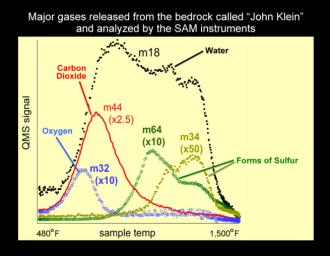An analysis of a drilled rock sample from NASA's Curiosity rover shows the presence of water, carbon dioxide, oxygen, sulfur dioxide, and hydrogen sulfide released on heating. The results analyzing the high temperature water release are consistent with smectite clay minerals.
Curiosity's Sample Analysis at Mars (SAM) instrument suite conducted the analysis. The first step in the analysis of a portion of this drilled sample was to heat the sample in a quartz oven to 1,535 degrees Farenheit (835 degrees Celsius) and analyze the gases as they were released using SAM's quadrupole mass spectrometer (QMS). The signatures of more than five hundred mass values were sampled during the heating of this drilled sample and analyzed by the QMS. Five are shown in the graph. These traces are diagnostic of water, carbon dioxide, oxygen, and two forms of sulfur (sulfur dioxide, the oxidized form, and hydrogen sulfide, the reduced form) measured by the QMS.
The second step in the analysis was to send a portion of the gas released from the sample to the tunable laser spectrometer (TLS) to measure isotopes of carbon, oxygen and hydrogen, in both water and carbon dioxide. The ratio of deuterium (a heavy form of hydrogen) to the lighter, more abundant form of hydrogen was lower than the deuterium-to-hydrogen ratio measured by SAM in more loosely bound water in the sample from the "Rocknest" drift. The high deuterium-to-hydrogen ratio in water in the Mars atmosphere is a signature of the lighter hydrogen more rapidly escaping to space over geological time. Therefore, measuring the deuterium-to-hydrogen in water released from rocks is one tool that can be used to explore ancient reservoirs of water on Mars.
The third step in the analysis was to inject gas trapped during the heating process into SAM's third instrument, the gas chromatograph. Individual compounds separate out in time in a long capillary column in this instrument and are then introduced into the QMS. The gas chromatograph mass spectrometer is a prime tool in the SAM search for organic compounds.
The ratio of reduced species to oxidized species released by the SAM ovens is significantly higher in this drilled bedrock than in the previously scooped dust samples. These results indicate a significant amount of available chemical energy because oxidized and less oxidized versions of molecules are present. This result, combined with suitable aqueous conditions at this site in the distant past, made this a potentially habitable environment.
The SAM analysis was conducted on Sol 200 (the 200th Martian day of Curosity's operations, which was Feb. 27, 2013, on Earth).
JPL manages the Mars Science Laboratory/Curiosity for NASA's Science Mission Directorate in Washington. The rover was designed, developed and assembled at JPL, a division of the California Institute of Technology in Pasadena.
For more about NASA's Curiosity mission, visit: http://www.jpl.nasa.gov/msl, http://www.nasa.gov/mars, and http://mars.jpl.nasa.gov/msl.

 Planetary Data System
Planetary Data System












